OS-cpu调度
CPU Scheduler
CPU调度器从进程ready队列中选择,并为他们分配CPU资源
当进程处于以下情况时,会发生CPU调度:
- 从running切换到waiting状态,如等待I/O
- 从running切换到ready状态,如中断发生
- 从waiting切换到ready状态,如I/O完成
- 进程结束
只存在1和4的调度是非抢占式的
一旦CPU被分配给一个进程,这个进程会保持它直到进程结束或等待I/O
nonpreemptive scheduling,也叫cooperative scheduling
包含2和3的调度是抢占式的
抢占式调度需要硬件支持,如timer
需要同步原语 (synchronization primitives)
是否需要同步 Single Core Multi-Core 抢占式 需要 需要 非抢占式 不需要 需要
Preemption
用户抢占 User Preemption (即使不支持内核抢占的硬件,也是支持用户抢占的)
- 从system call返回到user-space
- 从interrupt handler返回到user-space
- 不是发生在用户态的!是运行在用户态的线程/进程进行资源抢占,只能发生在内核态
内核抢占 Kernel Preemption
- When an interrupt handler exits, before returning to kernel-space
- When kernel code becomes preemptible again
- If a task in the kernel explicitly calls schedule()
- If a task in the kernel blocks (which results in a call to schedule() )
Scheduling Criteria
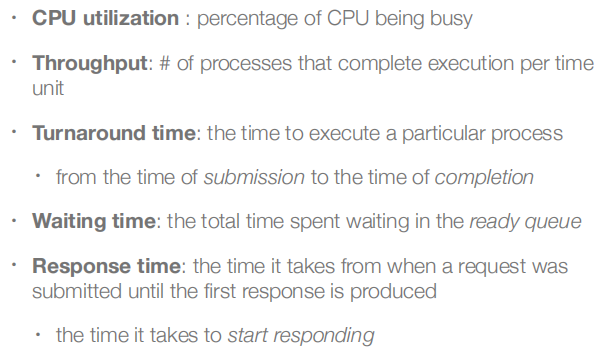
Turnaround time:任务提交到结束的时间
Waiting time:在ready队列中等待的时间
Response time:任务提交到响应的时间
Scheduling Algorithm
First-come, first-served scheduling (FCFS)
是非抢占式的

Shortest-job-first scheduling (SJF)
可以是抢占式的,也可以是非抢占式的
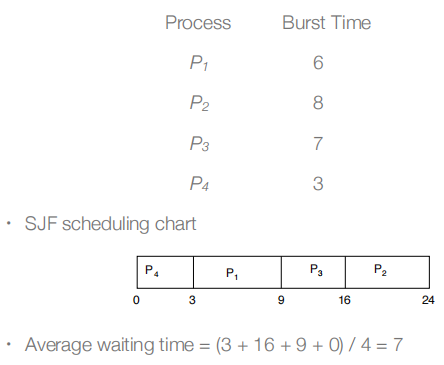
抢占式:Shortest-Remaining-Time-First
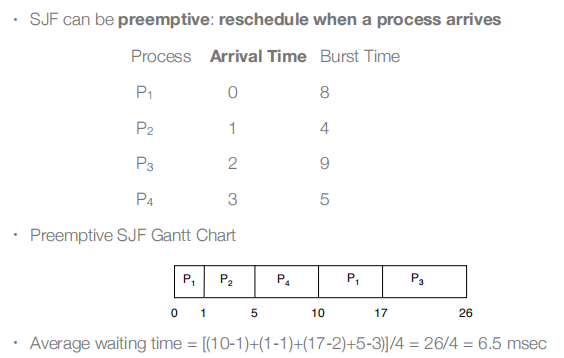
优:平均等待时间最少 可证明最优
劣:运行时很难知道需要多少时间
Priority scheduling 注意数字大不一定优先级高
可以抢占式,也可以非抢占式 (区分的关键在于,当新任务到来时需不需要重新进行调度)
会导致饥饿问题:low priority processes may never execute
解决方法:aging——逐步增加较长时间等待的进程的优先级
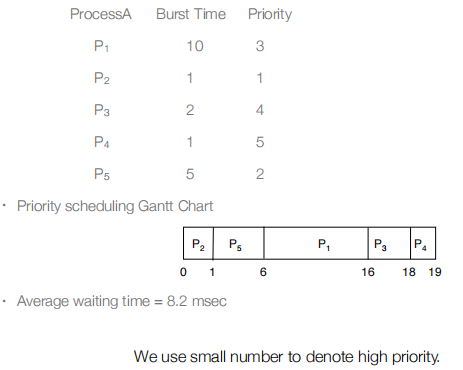
Round-robin scheduling (RR)
以循环的方式调度
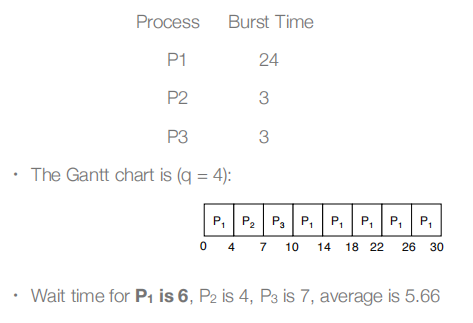
注意,P2只需要3个时间单位就能完成,不需要等q=4都用完,P3在第7个时间单位就能被调度,不是8
Multilevel queue scheduling
多级队列调度,ready队列被分为成单独的队列
e.g., foreground (interactive) and background (batch) processes
Multilevel feedback queue scheduling
a process can move between the various queues
• it tries to infer the type of the processes (interactive? batch?)
• aging can be implemented this way
the goal is to give interactive and I/O intensive process high priority
多处理器调度
对于多处理器调度,有两种方式:
asymmetric multiprocessing
• only one processor makes scheduling decisions, I/O processing, and other activity
• other processors act as dummy processing units
symmetric multiprocessing (SMP) :each processor is self-scheduling
• scheduling data structure are shared, needs to be synchronized
• used by common operating systems
SMP:Symmetric multiprocessing,每个处理器都是自我调度的
• All threads may be in a common ready queue (a)
• Or each processor may have its own private queue of threads (b)

CMT:chip multithreading 芯片多线程(?
好好好又没听
负载均衡
对于SMP,有两种方法
- Push migration: periodic task checks load on each processor, and if found pushes task from overloaded CPU to other CPUs
- Pull migration: idle processors pulls waiting task from busy processor
处理器亲和性 processor affinity
- Soft affinity:no guarantees,操作系统尽力使一个线程运行在同一个处理器上
- Hard affinity:由进程指定一组它可能在上面运行的处理器
NUMA和CPU调度
如果操作系统支持numa,它将内存分配给线程运行的CPU
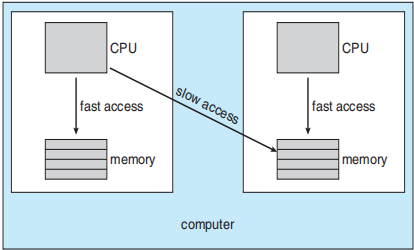
实时CPU调度
软实时系统:Critical real-time tasks have the highest priority, but no guarantee as to when tasks will be scheduled
硬实时系统:task must be serviced by its deadline,不会处理很复杂的任务
Linux调度
支持负载均衡,是NUMA-aware的,有Scheduling domain的概念
Scheduling domain is a set of CPU cores that can be balanced against one another.
Domains are organized by what they share (i.e. cache memory.)
Goal is to keep threads from migrating between domains
